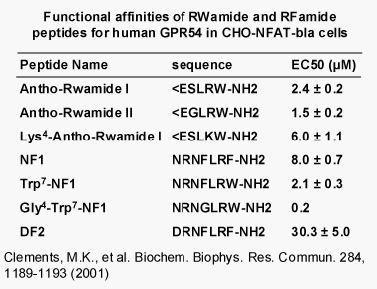Natural peptides displaying agonist activity on the orphan G protein-coupled receptor GPR54 were isolated from human placenta. These 54, 14 and 13 aminoacid peptides, with a common RF-amide C-terminus, derive from the product of KiSS-1, a metastasis suppressor gene for melanoma cells, and were therefore designated kisspeptins. They bound with low nanomolar affinities to rat and human GPR54 expressed in CHO-K1 cells, and stimulated PIP2 hydrolysis, Ca2+ mobilization, arachidonic acid release, ERK1/2 and p38 MAPK phosphorylation and stress fiber formation, but inhibited cell proliferation. Human GPR54 was highly expressed in placenta, pituitary, pancreas and spinal cord, suggesting a role in the regulation of endocrine function. Stimulation of oxytocin secretion following kisspeptin administration to rats confirmed this hypothesis.

Social Network Confirmation